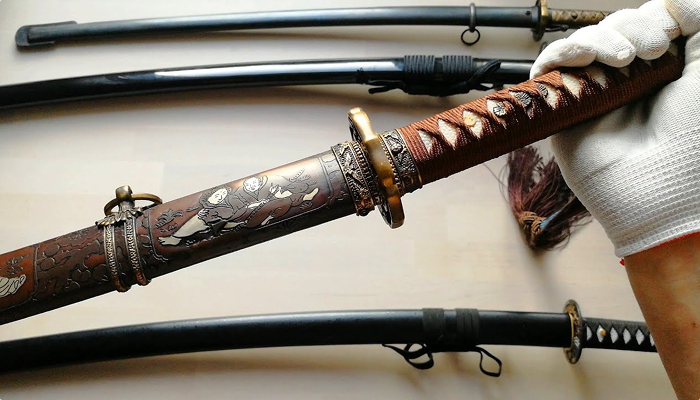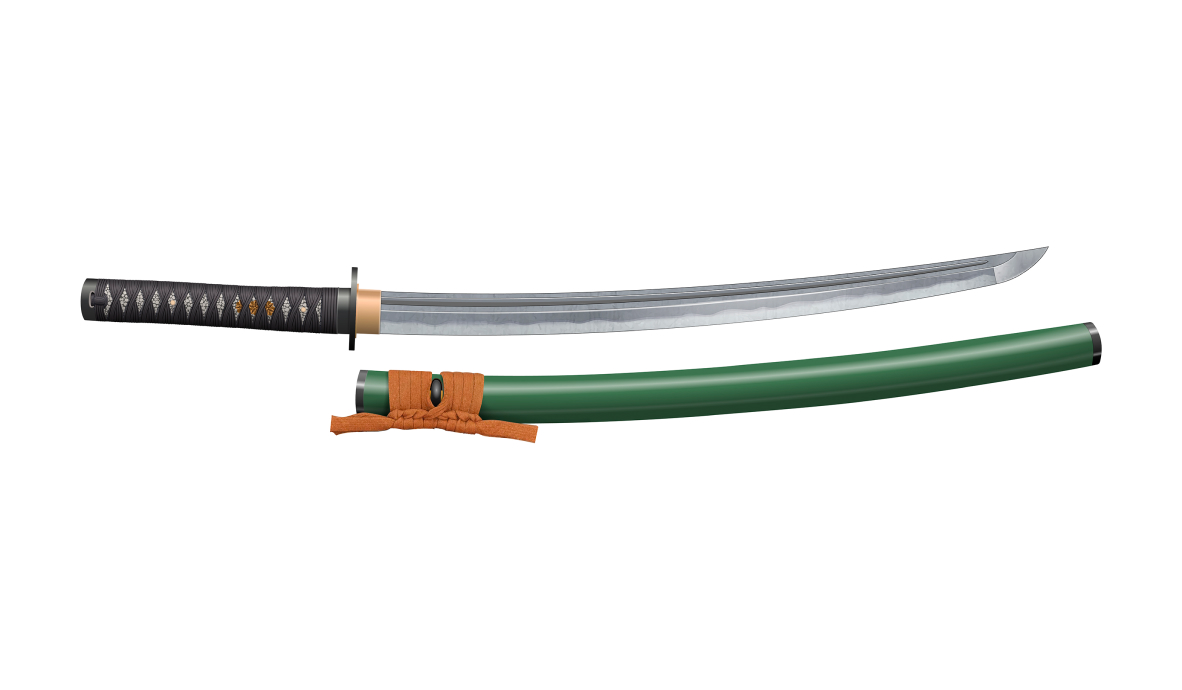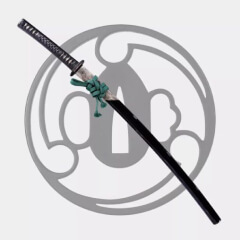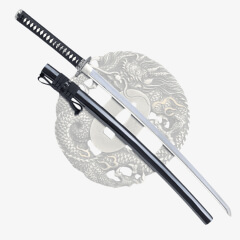- Samurai vs Ninja Swords
- Types of Japanese Swords
- The Grand History and Origins of Japanese Swords
- Characteristics and Features
- Examining a Japanese Sword
- Moutings
- Evaluation and Appraisals
Japanese Swords 101: A Guide for Both Novices and Enthusiasts

Throughout history, the Japanese sword served as a remarkable weapon used both in duels and on the battlefield. It has a very long history and has continued to evolve in response to historical events and battle tactics of the time. Today, these swords are primarily seen as works of art, and some people even use them in traditional Japanese martial arts.
We rounded up the most popular Japanese swords, as well as a few tips on how and where you can buy them.
- Samurai swords were highly valued and respected and were never used for mundane utilitarian purposes
- Some ninjas used their swords to open a locked door in an enemy sanctuary
- As an extra weapon for protection, ninja swords were used for stabbing enemies rather than slaying them
Samurai Swords vs. Ninja Swords (H2)
In feudal Japan, both the samurai and ninja clans used swords as weapons. Unlike the samurai, who were more concerned with the quality of their blades, the ninjas paid more attention to methods of quickly drawing their swords. The ninjas usually belonged to the lower classes of Japanese society, so they often had difficulty in obtaining high-quality blades.
- Samurai swords were highly valued and respected and were never used for mundane utilitarian purposes
- Some ninjas used their swords to open a locked door in an enemy sanctuary
- As an extra weapon for protection, ninja swords were used for stabbing enemies rather than slaying them
Unlike the samurai katana sword with a curved blade, ninja swords were generally straight and shorter. The ninjas commonly gathered abandoned swords found on the battlefield and shortened them. As assassins and mercenaries, they needed shorter shorts to keep a more subtle profile. Also, ninja swords were lighter and easier to draw from a scabbard.
Unlike the samurai katana sword with a curved blade, ninja swords were generally straight and shorter. The ninjas commonly gathered abandoned swords found on the battlefield and shortened them.
- The most popular of all swords, the Japanese katana sword is known to be the deadly curved sword of the samurai.
- Katana is a long sword over 60 cm, usually worn with the edge facing up, tucked into the belts of the warrior
- Less than 30 cm long, the tanto is a very short sword commonly used as a self-defense weapon and a utility knife
- The josun no tanto, meaning normal-sized tanto, have blades ranging from 24 to 25 cm in length, and mostly without curvature.
The Katana and the Tanto Dagger (H3)
| Type | Steel | Description | Handle Material | Series |
| Maru | Hagane (Hard Steel) | not laminated; poorest method | Bamboo wood | M32203 |
| Honsanmai | Kawagane & Shigane (Medium / Soft Steel) | most common lamination method | Premium wood | H09403 |
| Kobuse | Shigane (Soft Steel) | WW2 period swords | Super wood | K28983 |
| Soshu Kitae | Kawagane & Shigane (Medium / Soft Steel) | seven layers method; used by sword smith, Masumune | Quality wood | SK99239 |
The most popular of all swords, the Japanese katana sword is known to be the deadly curved sword of the samurai. Like the tachi, it is also curved and single-edged, but it has a shallow curve, which could cut down enemies with a single, lightning-fast strike.
Katana is a long sword over 60 cm, usually worn with the edge facing up, tucked into the belts of the warrior. The sword can be immediately used to make defensive or offensive motions. More than that, it can be drawn from both horseback or on foot, so it became the standard weapon for warriors.
Tachi the Long Sword (H4)
The first functional sword of Japanese design, the tachi was a single-edged sword with a curved blade. Unlike the straight and bulky design of older swords, it was designed for slashing rather than thrusting. The tachi is a long sword, more than 60 cm in length, so it was worn with the cutting edge down, and suspended from a belt. The tachi from the Kofun period traditionally featured the phoenix or dragon decoration. It was commonly drawn with one hand, usually from horseback. Since it was a sharp, durable, and effective weapon, it became the blueprint for all swords developed in later times.
Unlike the samurai katana sword with a curved blade, ninja swords were generally straight and shorter. The ninjas commonly gathered abandoned swords found on the battlefield and shortened them.
Katana is a long sword over 60 cm, usually worn with the edge facing up, tucked into the belts of the warrior. The sword can be immediately used to make offensive motions.
Throughout history, the Japanese sword served as a remarkable weapon used both in duels and on the battlefield. It has a very long history and has continued to evolve in response to historical events and battle tactics of the time.
Odachi, Great Tachi and Nagamaki Swords (H5)
Kodachi literally means small or short tachi, with a length less than 60 cm. It was actually too short to be called a sword, yet it was too long to be considered as a dagger. It is believed that high-ranking officials used kodachifor self-defense when not on the battlefield. Kodachiwas worn just like tachi, with the cutting-edge hanging down from the belt. The martial arts kodachijutsu focuses on the use of kodachi and short swords in general.
Wakizashi Shortest Sword of the Swords (H5)
The wakizashi is a short sword, usually between 30 and 60 cm long, and used as a backup of sorts. It became popular during the 16th century when samurai carried two swords through their belt. One of them was the longer katana, and the other was the shorter wakizashi sword. Since the latter had a shorter handle, it was only held in one hand.
While its kiriha-zukuri blade was ideal for thrusting and hacking, the hira-zukuri blade was designed for slicing. Many scholars believe that these two designs were later combined to create the first tachi sword
All Alcoholrehabhelp content is medically reviewed or fact checked to ensure as much factual accuracy as possible. We have strict sourcing guidelines and only link to reputable media sites, academic research institutions and, whenever possible, medically peer reviewed studies.
- SMART Recovery. “About SMART Recovery: 4-Point Program®: Addiction Recovery.”
- Moderation Management Public Hub. “Every Journey towards Control over Alcohol Has a Story...”
- Flanagin, Jake. “The Surprising Failures of 12 Steps.” The Atlantic, Atlantic Media Company2014.
- Glaser, Story by Gabrielle. “The Bad Science of Alcoholics Anonymous.” The Atlantic, 2019.
- Alcoholics Anonymous. “Historical Data: The Birth of A.A. and Its Growth in the U.S./Canada”,
- Kaskutas, Lee Ann. “Alcoholics Anonymous Effectiveness: Faith Meets Science.” Journal of Addictive Diseases, U.S. National Library Medicine, 2009.
All Alcoholrehabhelp content is medically reviewed or fact checked to ensure as much factual accuracy as possible. We have strict sourcing guidelines and only link to reputable media sites, academic research institutions and, whenever possible, medically peer reviewed studies.
- SMART Recovery. “About SMART Recovery: 4-Point Program®: Addiction Recovery.”
- Moderation Management Public Hub. “Every Journey towards Control over Alcohol Has a Story...”
- Flanagin, Jake. “The Surprising Failures of 12 Steps.” The Atlantic, Atlantic Media Company2014.
- Glaser, Story by Gabrielle. “The Bad Science of Alcoholics Anonymous.” The Atlantic, 2019.
- Alcoholics Anonymous. “Historical Data: The Birth of A.A. and Its Growth in the U.S./Canada”,
- Kaskutas, Lee Ann. “Alcoholics Anonymous Effectiveness: Faith Meets Science.” Journal of Addictive Diseases, U.S. National Library Medicine, 2009.
Frequently Asked Questions
To prevent rust, it is important to oil the blade of your samurai sword regularly. Use a high-quality sword oil, such as camellia oil or mineral oil, and apply it to the blade using a soft cloth. Be sure to wipe off any excess oil to prevent it from collecting dirt or debris.
To prevent rust, it is important to oil the blade of your samurai sword regularly. Use a high-quality sword oil, such as camellia oil or mineral oil, and apply it to the blade using a soft cloth. Be sure to wipe off any excess oil to prevent it from collecting dirt or debris.
To prevent rust, it is important to oil the blade of your samurai sword regularly. Use a high-quality sword oil, such as camellia oil or mineral oil, and apply it to the blade using a soft cloth. Be sure to wipe off any excess oil to prevent it from collecting dirt or debris.
To prevent rust, it is important to oil the blade of your samurai sword regularly. Use a high-quality sword oil, such as camellia oil or mineral oil, and apply it to the blade using a soft cloth. Be sure to wipe off any excess oil to prevent it from collecting dirt or debris.









